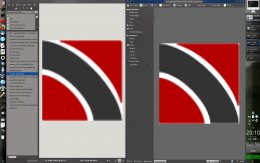Thomas Damgaard
2011-04-14 18:16:03 UTC
https://bugs.kde.org/show_bug.cgi?id=270980
Summary: Zooming in gwenview is more pixelated than in other
viewers
Product: gwenview
Version: 2.6
Platform: Ubuntu Packages
OS/Version: Linux
Status: UNCONFIRMED
Severity: normal
Priority: NOR
Component: general
AssignedTo: agateau-***@public.gmane.org
ReportedBy: thomasdn-***@public.gmane.org
Version: 2.6 (using KDE 4.6.2)
OS: Linux
When zooming in on a picture in gwenview the picture quickly becomes pixelated.
This is not the case for other viewers such as gqview, okular, several Mac and
Windows viewers.
Screenshot illustrating the difference between gqview and gwenview:
Loading Image...
I know that gwenview's "naive" zooming is closer to the original, however, it
should be possible to configure this. If you are viewing photos, you probably
just want to see what is most aesthetical, however, if you are a graphics
designer working on an image, you probably want to see the exact image.
Reproducible: Always
Steps to Reproduce:
Open an image and zoom in.
Actual Results:
Pixelated image.
Expected Results:
Smooth image.
Summary: Zooming in gwenview is more pixelated than in other
viewers
Product: gwenview
Version: 2.6
Platform: Ubuntu Packages
OS/Version: Linux
Status: UNCONFIRMED
Severity: normal
Priority: NOR
Component: general
AssignedTo: agateau-***@public.gmane.org
ReportedBy: thomasdn-***@public.gmane.org
Version: 2.6 (using KDE 4.6.2)
OS: Linux
When zooming in on a picture in gwenview the picture quickly becomes pixelated.
This is not the case for other viewers such as gqview, okular, several Mac and
Windows viewers.
Screenshot illustrating the difference between gqview and gwenview:
Loading Image...
I know that gwenview's "naive" zooming is closer to the original, however, it
should be possible to configure this. If you are viewing photos, you probably
just want to see what is most aesthetical, however, if you are a graphics
designer working on an image, you probably want to see the exact image.
Reproducible: Always
Steps to Reproduce:
Open an image and zoom in.
Actual Results:
Pixelated image.
Expected Results:
Smooth image.
--
Configure bugmail: https://bugs.kde.org/userprefs.cgi?tab=email
------- You are receiving this mail because: -------
You are watching all bug changes.
Configure bugmail: https://bugs.kde.org/userprefs.cgi?tab=email
------- You are receiving this mail because: -------
You are watching all bug changes.